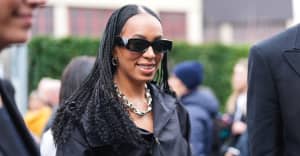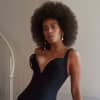Raun LaRose is Brooklyn-based menswear designer who has been working under his own name since 2009. He specializes in silhouette-driven, sportswear designs with a special emphasis on volume.
This month, when Solange Knowles and artist Toyin Ojih Odutola were featured in Cultured’s Art & Music issue, he got a bump in visibility. Each woman put on a pair of wide-legged Raun LaRose trousers, with Solange also wearing the designer’s take on the white turtleneck. “What’s really interesting to me is that that’s the photo everyone is sharing,” LaRose told The FADER over the phone. “Solange, the magazine — everyone has been posting that photo even though it’s not the cover [image].”
The moment caps an exciting time for the West Indian-American designer. Since he showed his debut Fall 2017 collection at New York Fashion Week, which featured oversized puffer coats, graphic hoodies and wide legged trousers, he’s seen interest from the teams of artists like Kendrick Lamar, Rihanna, and Migos. Having taken a break from showing in January to restructure the business side of things, LaRose took some time to talk about what this moment means for him and how his upbringing has influenced his approach to design.
How did Solange Knowles come to wear your designs for her Cultured Mag feature?
Solange Franklin, the stylist, reached out. I met her maybe six months prior to the shoot. We had a long conversation, she saw the collection, and there was great energy so we stayed in touch. I actually didn’t know it was Solange [the artist] until my friend Adrian Manuel sent me a screenshot and said, “Oh shit, Solange is wearing your pieces on Instagram.” She was posting from behind the scenes at the shoot.
What did that moment mean for you and your brand?
I’ve had a few celebrities that I’ve put [clothes] on before, but this is one of the more notable ones, and one of the more celebrated [occasions]. I think we all understand what Solange means to the culture, so to have that association is great for me because there are very few artists that I would want to put clothes on at this point, and she is one of them. I’ve never been a celebrity-driven designer, but figures like Solange, or people that just use their talent or voice to do something beyond just music, are of interest to me. She was one of the first black artists that allowed me to see another side of myself.
The pieces she wore were designed as menswear, right?
I think because I was raised mainly by my mom and she designed womenswear, that has some influence in what I do. Even though I stay firm in that I’m a menswear designer, I feel like there is room to blur the lines a little bit. What I appreciated is that these two strong women wore menswear and it still had a feminine appeal to it. Subtlety — that's always my goal.
Artist Toyin Ojih Odutula is also wearing your designs in the photo. Can you tell me about the collection they’re from?
Having done this for so long, I’ve realized it’s extremely difficult for young minority designers to get their point across equally. While I was designing [the Spring 2018 collection] I titled it System Down, because I kept thinking about the system — the system that is supposed to help us and promote talent and nurture us. There’s really no system in place that I personally feel like does that evenly for black designers.
As a designer, people are always telling you you should do this [thing] or that [thing], or that this [thing] might bring you more money. I wanted to create something that was my concept and idea, and that was it. The actual inspiration came from tech culture a bit. I also took some of the more relaxed silhouettes but made them more voluptuous, tweaking them and adding more pleating and higher hemlines.
Can you speak a bit more about the uneven system you mentioned earlier?
When I first started out [in fashion], I met this photographer who I was supposed to be working with. He said to me, “I really wasn’t surprised about the fact that you were from Brooklyn, what surprised me was the fact that you were black.” I think that’s left a negative impression on me. It’s like there was this idea about what a black designer’s pieces were supposed to look like.
I’m first generation West Indian-American. I grew up here but my parents are from Guyana. In most cases, the perception is that I’m supposed to embrace my roots and my heritage. If you see a designer that is African, they are supposed to embrace their African roots and that heritage — that is what the attention grabber is for the outside world because that’s what they want to see you as. That’s always the problem that I have had. We are never allowed an even playing field. We aren’t ever granted a blank slate where we get to start a narrative based on how we feel. When you have a white designer they can have inspirations from God knows where, but if it’s a black designer [who isn’t specifically inspired by what people perceive to be their culture] then you’re “not being true to who you are.”
In the past I’ve even [encountered] people who will say, “You don’t really have the point of view of a black designer,” and that’s offensive. It’s like, sure, there are some designers who do what you’re describing as a “black designer’s point of view,” but they are doing that as their passion and shouldn’t be stereotyped [based on that].


